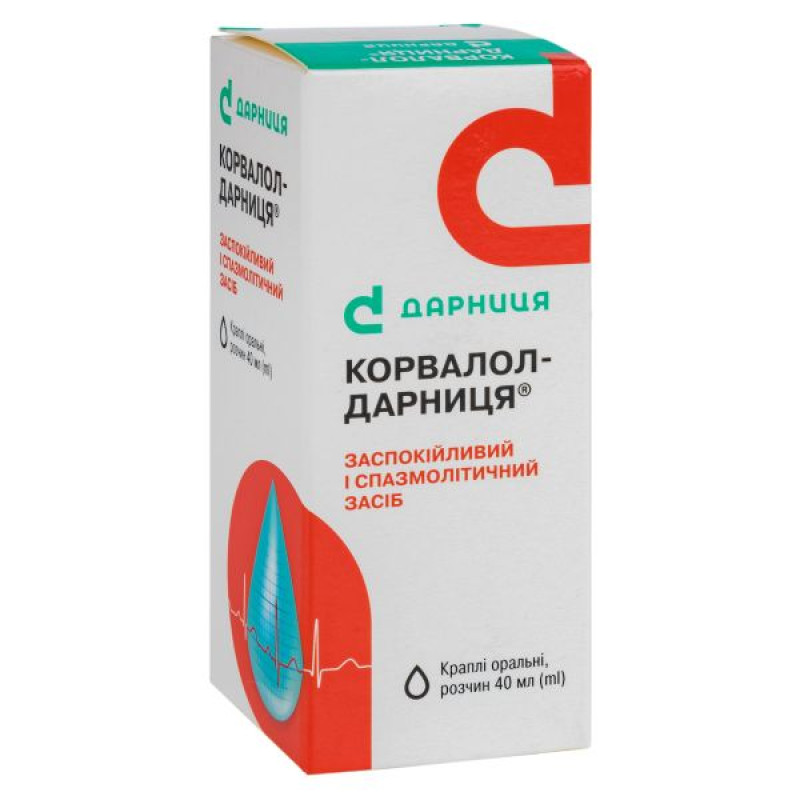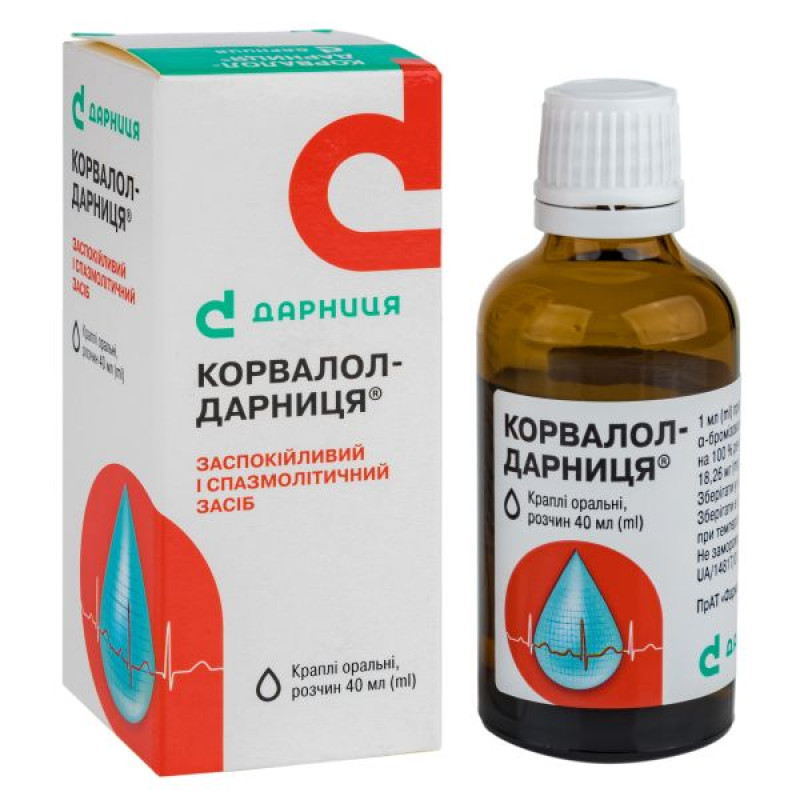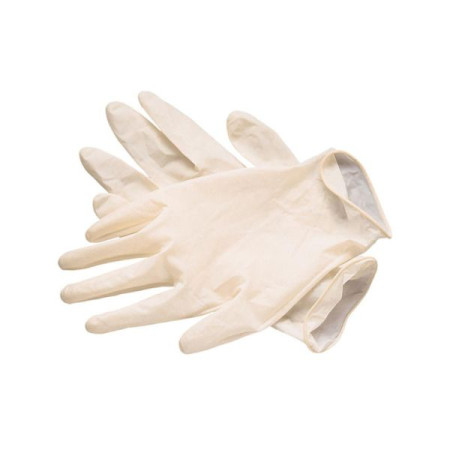Corvalol-Darnitsa drops 40 ml

Instructions for Corvalol-Darnitsa drops 40 ml
Composition
active ingredients: ethyl ester of α-bromoisovaleric acid, phenobarbital, peppermint oil;
1 ml of the drug contains ethyl ester of α-bromoisovaleric acid, calculated as 100% substance 20.0 mg, phenobarbital 18.26 mg, peppermint oil 1.42 mg.
Excipients: ethanol 96%, potassium isovalerate, purified water.
Dosage form
Oral drops, solution.
Main physicochemical properties: colorless transparent liquid with a characteristic ethereal odor.
Pharmacotherapeutic group
Hypnotics and sedatives. Barbiturates in combination with other components. ATX code N05C B02.
Pharmacological properties
Pharmacodynamics.
Corvalol-Darnitsa® is a sedative and antispasmodic, the effect of which is determined by the components that make up its composition.
Ethyl ester of α-bromizovaleric acid has a reflex sedative and antispasmodic effect, caused by irritation mainly of receptors of the oral cavity and nasopharynx, a decrease in reflex excitability in the central nervous system, an increase in inhibition phenomena in neurons of the cortex and subcortical structures of the brain, as well as a decrease in the activity of central vasomotor centers and a direct local antispasmodic effect on vascular smooth muscles.
Phenobarbital inhibits the activating effects of the centers of the reticular formation of the medulla oblongata on the cortex of the cerebral hemispheres, thereby reducing the flow of excitatory effects on the cerebral cortex and subcortical structures. The reduction of activating effects causes, depending on the dose, sedative, tranquilizing or hypnotic effects. Corvalol-Darnitsa® reduces the excitatory effects on vasomotor centers, coronary and peripheral vessels, reducing overall blood pressure, relieving and preventing vascular spasms, especially cardiac ones.
Mint oil contains a large number of essential oils, including approximately 50% menthol and 4-9% menthol esters. They are able to irritate the "cold" receptors of the oral cavity and reflexively dilate mainly the vessels of the heart and brain, relieving spasms of smooth muscles, has a calming and mild choleretic effect. Peppermint oil has antiseptic and antispasmodic effects, the ability to eliminate flatulence. Irritating the receptors of the mucous membrane of the stomach and intestines, it enhances intestinal peristalsis.
Pharmacokinetics.
When taken orally, absorption begins already in the sublingual area, the bioavailability of the components is high (approximately 60-80%). The effect develops especially quickly (after 5-10 minutes) when kept in the mouth (sublingual absorption) or taken on a sugar lump. The effect develops after 15-45 minutes and lasts for 3-6 hours. In people who have previously taken barbituric acid drugs, the duration of action is reduced due to the accelerated metabolism of phenobarbital in the liver, where barbiturates cause enzyme induction. In the elderly and in patients with cirrhosis of the liver, the metabolism of the drug Corvalol-Darnitsa® is reduced, so their half-life is prolonged, which requires a dose reduction and lengthening of the intervals between doses of the drug.
Indication
– Neuroses with increased irritability.
– Insomnia.
– In the complex therapy of hypertension and vegetative-vascular dystonia.
– Mild coronary spasms, tachycardia.
– Intestinal spasms (as an antispasmodic).
Contraindication
– Hypersensitivity to the components of the drug, to bromine;
– severe liver and/or kidney dysfunction;
– hepatic porphyria;
– severe heart failure;
– medicines containing phenobarbital are contraindicated in severe arterial hypotension, acute myocardial infarction, diabetes mellitus, depression, myasthenia gravis, alcoholism, drug and medication addiction, respiratory diseases with shortness of breath, obstructive syndrome.
– Pregnancy and breastfeeding.
– Children under 18 years of age.
Interaction with other medicinal products and other types of interactions
Centrally depressant drugs enhance the effect of Corvalol-Darnitsa®. The effect of the drug is enhanced by the use of valproic acid drugs and alcohol.
Phenobarbital induces liver enzymes and, accordingly, may accelerate the metabolism of some drugs that are metabolized by liver enzymes (including indirect anticoagulants, cardiac glycosides, antimicrobial, antiviral, antifungal, antiepileptic, anticonvulsant, psychotropic, oral hypoglycemic, hormonal, immunosuppressive, cytostatic, antiarrhythmic, antihypertensive drugs).
Phenobarbital enhances the effects of analgesics and local anesthetics.
MAO inhibitors prolong the effect of phenobarbital.
Rifampicin may reduce the effect of phenobarbital. When used with gold preparations, the risk of kidney damage increases. With prolonged simultaneous use with nonsteroidal anti-inflammatory drugs, there is a risk of stomach ulcers and bleeding. Simultaneous use of drugs containing phenobarbital with zidovudine increases the toxicity of both drugs. The drug increases the toxicity of methotrexate.
Application features
During treatment with the drug, it is not recommended to engage in activities that require increased attention, rapid mental and motor reactions.
Simultaneous consumption of alcoholic beverages should be avoided.
The presence of phenobarbital in the composition of the drug may lead to the risk of developing Stevens-Johnson and Lyell syndrome, which is most likely in the first weeks of treatment.
Long-term use of the drug is not recommended due to the risk of developing drug dependence, possible accumulation of bromine in the body, and the development of bromine poisoning.
If the pain in the heart area does not go away after taking the drug, you should consult a doctor to rule out acute coronary syndrome. Use with caution in cases of arterial hypotension, hyperkinesia, hyperthyroidism, adrenal hypofunction, acute and chronic pain syndrome, and acute drug intoxication.
This medicine contains 56% by volume of ethanol (alcohol).
The minimum dose of the drug (15 drops) contains 254 mg of ethanol, which is equivalent to 6.4 ml of beer or 2.7 ml of wine. Harmful for patients suffering from alcoholism. Caution should be exercised when using in patients with liver disease and epilepsy.
Use during pregnancy or breastfeeding
Do not use during pregnancy or breastfeeding.
The ability to influence the speed of reactions when driving vehicles or other mechanisms
Corvalol-Darnitsa® contains phenobarbital and ethanol, therefore it may cause impaired coordination, psychomotor speed, drowsiness and dizziness during treatment. In this regard, it is not recommended to engage in activities that require increased attention, including driving and working with other mechanisms.
Method of administration and doses
Corvalol-Darnitsa® should be taken orally, regardless of meals, 2-3 times a day, 15-30 drops with water or on a piece of sugar. If necessary (pronounced tachycardia and spasm of coronary vessels), a single dose can be increased to 40-50 drops.
The duration of use of the drug is determined by the doctor depending on the clinical effect and tolerability.
Children
There is no experience in the treatment of children, therefore the drug should not be used in pediatric practice.
Overdose
Overdose is possible with frequent or long-term use of the drug, which is associated with the cumulation of its components. Long-term and constant use can cause addiction, withdrawal syndrome, and psychomotor agitation.
Symptoms: respiratory depression, up to its cessation; CNS depression, up to coma; cardiovascular depression, including rhythm disturbances; decreased blood pressure, up to a collapse-like state; nausea, weakness, decreased body temperature, decreased diuresis.
Treatment is symptomatic.
Side effects
Corvalol-Darnitsa® is generally well tolerated. In some cases, the following side effects may occur:
from the digestive system: constipation, feeling of heaviness in the epigastric region, with prolonged use - impaired liver function, nausea, vomiting;
from the nervous system: weakness, ataxia, impaired coordination of movements, nystagmus, hallucinations, paradoxical excitation, fatigue, slowed reactions, headache, cognitive impairment, confusion, drowsiness, mild dizziness, decreased concentration;
Immune system disorders: hypersensitivity reactions, including angioedema;
Skin and mucous membranes: allergic reactions, including skin rash, itching, urticaria, Stevens-Johnson syndrome, toxic epidermal necrolysis;
from the blood system: anemia, thrombocytopenia, agranulocytosis;
Respiratory system: difficulty breathing;
Cardiovascular system: bradycardia, hypotension;
On the part of the musculoskeletal system: with prolonged use of drugs containing phenobarbital, there is a risk of osteogenesis disorders.
With prolonged use, bromine poisoning is possible.
Symptoms: central nervous system depression, depression, ataxia, apathy, rhinitis, conjunctivitis, acne or purpura, lacrimation, confusion.
These phenomena disappear when the dose is reduced or the drug is discontinued.
Expiration date
2 years.
Storage conditions
Store in the original packaging at a temperature not exceeding 25 ° C. Do not freeze. Keep out of the reach of children.
Packaging
25 ml or 40 ml in a bottle; 1 bottle in a pack.
Vacation category
Bottle of 25 ml - without a prescription.
40 ml bottle – by prescription.
Producer
PrJSC "Pharmaceutical Company "Darnitsa".
Location of the manufacturer and its business address
Ukraine, 02093, Kyiv, Boryspilska St., 13.
There are no reviews for this product.
There are no reviews for this product, be the first to leave your review.
No questions about this product, be the first and ask your question.







